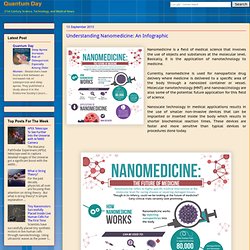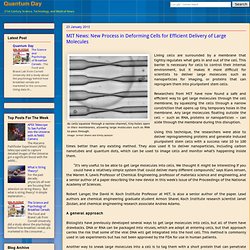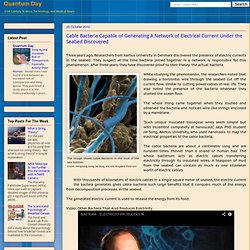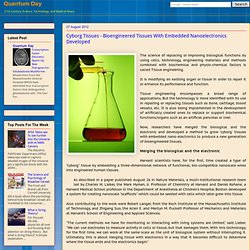

Tiny Nanomotors Successfully Placed Inside Live Human Cells For The First Time. Scientists have successfully placed tiny synthetic motors in live human cells through nanotechnology.

Long Term Implantable Bio-Sensors Developed Using Carbon Nanotubes. Using carbon nanotubes, scientists have developed a biosensor that can be implanted under the skin that will last more than a year.

They have also developed a short term biosensor that can travel through the blood stream flowing through the different organs of the body without causing damage. In order to get a reading and collect data from the sensors, a laser that produces near-infrared light is used to detect the fluorescent signal off of the nanotube based devices. The long term biosensor was made to detect nitric oxide (NO) levels in the body for monitoring cancerous cells. Quantum Day. Understanding Nanomedicine: An Infographic. Nanomedicine is a field of medical science that involves the use of objects and substances at the molecular level.

Basically, it is the application of nanotechnology to medicine. Currently, nanomedicine is used for nanoparticle drug delivery where medicine is delivered to a specific area of the body through a nanosized container or vessel. Molecular nanotechnology (MNT) and nanovaccinology are also some of the potential future application for this field of science. Nanoscale technology in medical applications results in the use of smaller non-invasive devices that can be implanted or inserted inside the body which results in shorter biochemical reaction times.
These devices are faster and more sensitive than typical devices or procedures done today. Nanogel Based Therapy For Treatment of Systemic Lupus Erythematosus. Nanogels are nano sized particles made up of very absorbent, gelatinous polymers (chemical compounds consisting of repeating structural units) called hydrogels.

Nanogels are very small and has pores that can filled with molecules. These properties make nanogels ideal for medical applications such as a drug delivery or drug containment system. These nanogels can be engineered to break open or rupture to certain environmental or chemical conditions. Controlling where, when, and how much of a drug is to be released results in a more effective and targeted drug delivery. Recently, scientists are developing nanogels as a delivery system to treat patients suffering from Lupus, an autoimmune disorder that may affect the skin, joints, kidneys, brain, and other organs.Nanogel Based Delivery System For Lupus Patients. DNA Nanotechnology: Building Matter and Controlling Architecture of DNA Building Blocks.
Chad A.

Mirkin of Northwestern University has developed a process to build artificial nanostructures with customized properties in a highly programmable way from the bottom up, just like how nature does it. Advances in nanotechnology have opened up the development and application of artificial nanostructures. Nanostructures give support, assist in a process, or brings out a particular property from a created device.
There are two types of nanostructures, structural and dynamic. Structural nanostructures are used as a foundation for building more complex structures. Just like Lego building blocks, nanostructures can be made up of smaller structures. These are very useful in many applications. MIT News: New Process in Deforming Cells for Efficient Delivery of Large Molecules. Living cells are surrounded by a membrane that tightly regulates what gets in and out of the cell.

This barrier is necessary for cells to control their internal environment, but it makes it more difficult for scientists to deliver large molecules such as nanoparticles for imaging, or proteins that can reprogram them into pluripotent stem cells. Researchers from MIT have now found a safe and efficient way to get large molecules through the cell membrane, by squeezing the cells through a narrow constriction that opens up tiny, temporary holes in the membrane. Any large molecules floating outside the cell — such as RNA, proteins or nanoparticles — can slide through the membrane during this disruption. Using this technique, the researchers were able to deliver reprogramming proteins and generate induced pluripotent stem cells with a success rate 10 to 100 times better than any existing method. “It’s very useful to be able to get large molecules into cells.
Cable Bacteria Capable of Generating A Network of Electrical Current Under the Seabed Discovered. Three years ago, Researchers from Aarhus University in Denmark discovered the presence of electric currents in the seabed.

They suspect at the time bacteria joined together in a network is responsible for this phenomenon. After three years, they have discovered proof to their theory: the actual bacteria.While studying the phenomenon, the researchers noted that drawing a horizontal wire through the seabed cut off the current flow, similar to cutting power cables in real life. They also noted the presence of the bacteria whenever they studied the ocean floor. The whole thing came together when they studied and observed the bacteria and noticed wire-like strings enclosed by a membrane. “Such unique insulated biological wires seem simple but with incredible complexity at nanoscale,” says PhD student Jie Song, Aarhus University, who used nanotools to map the electrical properties of the cable bacteria.
The generated electric current is used to release the energy from its food. Bio Nanotech Transient Electronics For Medical and Commercial Use Dissolve After Completing Its Task. In the 1966 movie, Fantastic Voyage, a crew of five was reduced to microscopic size and injected into a human body.

Their goal was to repair a blood clot in the brain and leave before they all revert back to their original size. Almost fifty years later, nanotechnology as the movie has shown, may be the next step forward not only in medical procedures but commercial and industrial applications as well. Aside from stem cell research, nanotechnology is gaining wide popularity in medical and scientific research. Quantum Day : Cyborg Tissues - Bioengineered Tissues With Embedded Nano-Electronics Developed. The science of replacing or improving biological functions by using cells, technology, engineering materials and methods combined with biochemical and physio-chemical factors is called Tissue engineering.

It is modifying an existing organ or tissue in order to repair it or enhance its performance and function. Tissue engineering encompasses a broad range of applications. But the technology is more identified with its use in repairing or replacing tissues such as bone, cartilage, blood vessels, etc.